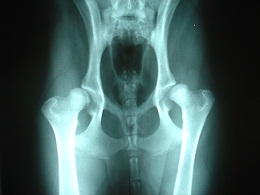
An estimated 65-70% of young puppies (not older dogs) display hip dysplasia when screened with an X-ray. This number includes young puppies that are not showing symptoms; with no lameness or any other symptoms of pain that would be visible to you or I. I found this number to be staggering when you consider that this veterinarian was talking about puppies less than one year old.
What is Hip Dysplasia?
Hip dysplasia is similar to a "ball and socket" kind of condition. The simplest explanation is that, the joint does not fit right or it "pops" out of line (socket). A cat or a dog can be born with this condition; or, it may result from activity and stress experienced throughout the animals life. Veterinarians face several different scenarios here; this is a condition that larger breed dogs are normally prone to developing. However, this veterinarian was describing all young puppies large and small breed which he had studied.
The more fundamental question is this. If young animals have this condition, it generally worsens. Most animals are not demonstrating symptoms this early in life, but as it progresses, pain and disability are inevitable.
Working on the Problem Now
For an adult pet that already has symptoms, you can use a safe and effective approach by using a high-quality liquid glucosamine formula. (some remedies made available by veterinarians may not be the best fit for you pet so do some research first.)
So, what should you do?
For those of us who have younger pets, why wait? You should not need the expense of an x-ray to make a decision about this? By nature, pets are playful and active. The eventual consequence is that some day they will develop joint pain as a result of trauma, aging, or sometimes both.
A Simple Solution
Be proactive. As adults, many of us wish we had done more to care for our joints earlier in life, I know I do. Most of us take vitamins and minerals as supplements and the smart consumer is using a liquid glucosamine.
The cost of the liquid formulas is low and is given to pets based on body weight. For smaller animals, the cost is negligible, especially when compared to the potential for problems down the road. For a pet that weighs 10-20 pounds, we are talking about pennies a day. There is no reason to wait until your pet is in pain and suffering.




